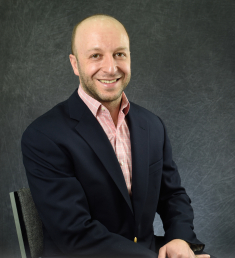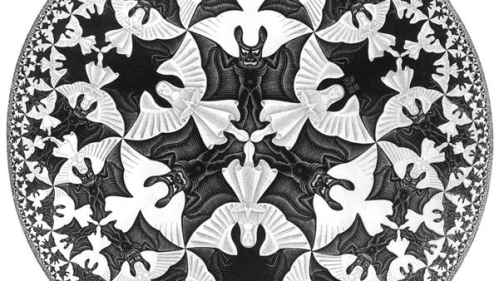Rutgers mathematician co-hosts a workshop on higher dimensional geometry
The artist M. C. Escher brought complex mathematical ideas to life through dizzying illustrations like Circle Limit IV (Heaven and Hell), in which angels and demons soar through an infinite, bowl-shaped space. Their winged bodies form a pattern that mathematicians call a lattice.
In December, a Rutgers University-New Brunswick mathematician will co-host a workshop, convened by the American Institute of Mathematics and National Science Foundation, to ask, among other things: How would those angels and demons look if Escher’s drawing were 22-dimensional? Or 1,001-dimensional? Or in any number of other dimensions?
Welcome to the world of “hyperbolic reflection groups,” the name for the type of geometric space Escher depicted in his Circle Limit engravings. They represent what you’d see if you placed a single object – say a single angel-devil picture – at the bottom of a bowl and surrounded it by mirrors to make the image reflect itself, over and over, infinitely.
“It’s not unlike what you see when you’re surrounded by mirrors in a dressing room or barbershop, but in a barbershop you’re standing on flat ground, not the bowl-shaped hyperbolic space that Escher depicted. That gives a completely different geometry for the ways your reflections will line up with each other and the patterns they’ll create,” said Alex V. Kontorovich, a professor of mathematics at Rutgers-New Brunswick’s School of Arts and Sciences and an organizer of the “Arithmetic Reflection Groups and Crystallographic Packings” workshop which begins Dec. 14.

On the flat floor of a barbershop, it’s easy to arrange the mirrors in different ways so that your endless reflections will create a nice, orderly lattice pattern. Mathematicians have known since 1934 that this would hold true in a flat-floored barbershop with any number of dimensions, even though it’s impossible to imagine what that would look like.
But the geometries of a bowl-shaped or hyperbolic floor make it much harder to line up the mirrors and get an Escher-
like lattice. Mathematicians have worked out that you simply can’t do it in hyperbolic spaces of 20, 30 or 1,000 dimensions. But for infinite numbers of other dimensions, it is not yet known whether such a pattern can exist.
Kontorovich and the workshop’s other mathematicians, representing the fields of geometry, topology, dynamics, arithmetic groups and number theory, intend to find out. The effort may take years, and what they learn might benefit other branches of mathematics.
Or it could be that the mystery, like Escher’s swooping angels and demons, goes on forever, becoming infinitely more obscure as it recedes into the distance.



